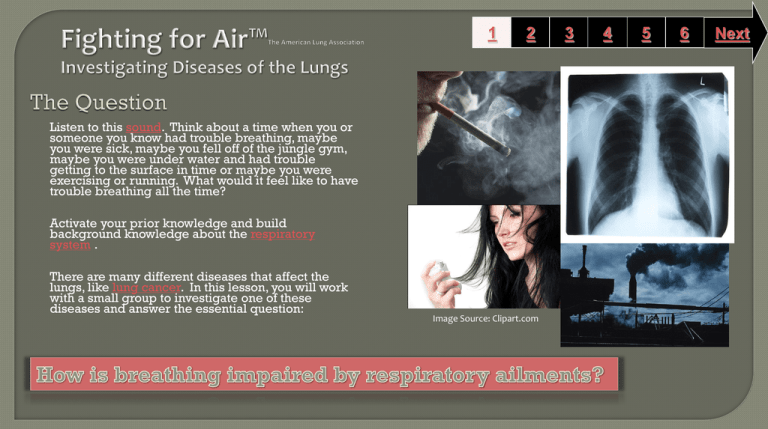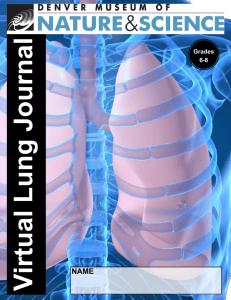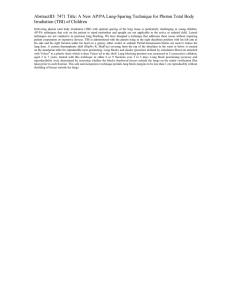
1
2
Listen to this sound. Think about a time when you or
someone you know had trouble breathing, maybe
you were sick, maybe you fell off of the jungle gym,
maybe you were under water and had trouble
getting to the surface in time or maybe you were
exercising or running. What would it feel like to have
trouble breathing all the time?
Activate your prior knowledge and build
background knowledge about the respiratory
system .
There are many different diseases that affect the
lungs, like lung cancer. In this lesson, you will work
with a small group to investigate one of these
diseases and answer the essential question:
Image Source: Clipart.com
3
4
5
6
Next
1
2
3
4
5
6
Next
Use these resources to help you gather information about
the disease you are investigating:
American Lung Association
1. COPD
Visual Thesaurus
2. Asthma
Use to look up the diseases or
words you find in your articles.
3. Pneumonia
4. Lung Cancer
Gale Science In Context
Search for:
1. Asthma
2. Emphysema/COPD
3. Bronchitis
4. Black Lung
5. Lung Cancer
An electron micrograph scan of coal dust (marked by dark
patches) in lung tissue infected with black lung disease. A
disease found primarily in older coal workers, black lung is
characterized by thickening and scarring of lung tissue.
Image Source: Gale Sciene in Context
Photograph by Hans-Freider and Astrid Michler
1
2
3
4
5
First, select a disease to study:
1. Asthma
2. Emphysema/COPD
3. Bronchitis/Pneumonia
4. Black Lung
5. Lung Cancer
Use this chart to make notes and answer
questions. Include links to pictures and
other resources you may want to use in a
presentation to the class.
1. How do these diseases affect the
lungs?
2. How is breathing impacted?
3. How does this disease impact your
overall health?
4. What can be done to help prevent
these diseases?
X-Ray showing cancer in the left lung
Image Source: Gale Science in Context
6
Next
1
2
3
4
5
6
Next
Create a PSA to inform your school
community about the respiratory disease you
researched. Your PSA must include a precise
description of how breathing is impeded by
the disease, and should encourage people to
keep their lungs healthy. You can choose any
of the following Web 2.0 tools or another
presentation tool approved by your teacher:
Glogster- Create an interactive poster
ShowBeyond - Create and share a Slidecast in
three easy steps
Prezi - Presentation mapping tool
Infographic
Use this rubric to guide you.
As you view and listen to your classmates’
presentations, think about and discuss which
respiratory ailments might present the
greatest risk or be most difficult to prevent.
A normal lung (left) and the lung of a cigarette smoker (right).
Image Source: Gale Science in Context
•A child who lives with a parent who
smokes
•Someone who lives in a polluted city
vs. the country
•The air at your school
1
2
3
4
5
6
Watch this video to learn more about
Asthma
BrainPop Video on Asthma
Play this fun game comparing running
ability of smokers and non-smokers
Lung Race Game
Another fun game about keeping your
lungs healthy
Tar Game
Computerized tomographic view of the lungs, showing the trachea (center)
splitting to form the two main bronchi, which lead to the lungs. Inside the lungs,
many branching bronchi terminate in alveoli, air sacs where gas exchange takes
place.
Image Source: Gale Science in Context
Watch this video to learn more about
smoking and how it affects the lungs
BrainPop Video on Smoking*
*NOTE: Go to the BCPS Database page
and click on BrainPOP, then return to
this slide and click on the video link
above.
Visit the American Cancer Society to
learn more about lung cancer.
Next
1
BCPS Curriculum
Students will analyze data obtained from observations of real-life events and make
predictions about the impact of gas laws on the human body.
Maryland State Curriculum
3.5.3 The student will investigate how natural and man-made changes in
environmental conditions will affect individual organisms and the dynamics of
populations.
3.2.1 The student will explain processes and the function of related structures found
in unicellular and multicellular organisms.
Common Core State Standards
Reading: 1. Read closely to determine what the text says explicitly and to make
logical inferences from it; cite specific textual evidence when writing or speaking to
support conclusions drawn from the text.
Writing: 7. Conduct short as well as more sustained research projects based on
focused questions, demonstrating understanding of the subject under investigation.
Standards for the 21st Century Learner
1.1.6 Read, view, and listen for information presented in any format (e.g. textual,
visual, media, digital) in order to make inferences and gather meaning.
2.1.3 Use strategies to draw conclusions from information and apply knowledge to
curricular areas, real-world situations, and further investigations.
Maryland Technology Literacy Standards for Students
3.0: Use a variety of technologies for learning and collaboration.
2
3
4
5
6
Time Frame: 75 minutes
Differentiation:
Direct students to use comprehension tools included in
databases, such as: audio read-aloud, labeled reading
levels, and embedded dictionaries.
Research resources are differentiated by reading level
using sliver/gold stars (basic/challenging)
Learning Styles:
Visual
Kinesthetic
AVID Strategies:
Notes to the teacher:
You may want to share the PSAs created with the entire
school community on your school WIKI.
Visual Thesaurus Tutorial
Web2.0 Resources from the LIS Wiki:
Glogster
Prezi
ShowBeyond
Last updated: July 2015
Created by Kim O’Donnell . Library Media Specialist
BCPS Slam Dunk Research Model, Copyright 2012, Baltimore County Public Schools, MD, all rights reserved. The models may be used for educational, non-profit school use only.
All other uses, transmissions, and duplications are prohibited unless permission is granted expressly. This lesson is based on Jamie McKenzie’s Slam Dunk Lesson module.









